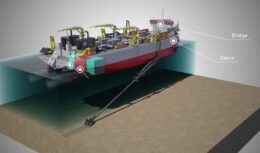
Minerals that are “lost” at the bottom of the sea can be mined and a new form of mining is causing controversy
Since time immemorial, our planet has been the scene of complex natural processes that have shaped its structure. A captivating example of this marvel is the formation of minerals from shark teeth, sedimented in the oceanic depths for hundreds of meters. Over millions of years, these minerals accumulated, generating a treasure trove of precious rocks that has now become the epicenter of a fierce global dispute: deep-sea mining, according to the site Notícias Concursos.
Mining the Deep Sea: The Quest for Precious Minerals
In the abyssal depths of the ocean, between 800 and 6.000 meters below the surface, there are vast reserves of precious minerals, including copper, cobalt, nickel, zinc, silver, gold and elements of rare earths. These minerals play a vital role in producing technologies ranging from solar panels to electric car batteries.
While advocates argue that these resources are crucial to fueling the transition to a low-carbon economy, critics, including environmentalists, researchers and traditional communities, warn of potential negative impacts on biodiversity and global warming if this new exploratory frontier is opened without caution. .
Riches hidden in the depths and their geological formations
Deep-sea minerals exist in different geological formations: polymetallic nodules, polymetallic sulfides, and cobalt-rich seamount crusts. The polymetallic nodules, known to be formed from shark teeth and similar debris, cluster in the abyssal plains over the sand.
On the other hand, polymetallic sulfides, compounds of sulfur and different metals, develop around sources hydrothermal at depths between 1.000 and 4.000 meters, where underwater volcanic activity is intense. The crusts of seamounts, located between 800 and 2.500 meters, have significant amounts of valuable minerals, especially cobalt.
The emerging era of underwater mining
As much as the richness of the ocean floor has been known for some time, recent technological advances and growing commercial interest have finally made deep-sea mining a tangible possibility. However, even after decades of research, knowledge about these abyssal regions remains limited.
The exploitation of mineral reserves at the bottom of the sea has triggered a complex global debate. due to location predominantly of these minerals, extraction depends on the decisions of the International Seabed Authority (ISA), an entity linked to the UN.
Divisions and Concerns: Challenges of Subsea Mining
Undersea mining has generated divisions between nations and alliances. Countries such as China, Norway, Mexico and the United Kingdom support this exploration, while a group of 21 countries, including Brazil, defend a moratorium to assess the impacts before proceeding. In the case of Brazil, along with other nations, a break of at least ten years is proposed. However, environmental concerns related to seabed mining are considerable, given its high environmental disturbance, sediment movement and waste generation.
The deep sea, comprising over 90% of the marine environment, plays a crucial role in planetary regulation by absorbing and storing significant amounts of carbon dioxide from the atmosphere. Furthermore, these areas hide unique ecosystems and ancient life forms adapted to extreme conditions.
As science advances and debates continue, the future of deep-sea mining remains uncertain. The balance between human development and the preservation of the deep marine ecosystem, which is vital for our planet, is the challenge ahead.









How embarrassing! Before writing any article,…
TO COMPLETE THESE THEY PUT GENERAL WATERMELON🍉 TOMÁS…
Approved. Where to find? What is the estimated price?…
WHAT A DISSERVICE! The solution to waste…
Very cool!
35 tons of gold went to…
Throwing a lot of rubbish into the sea...
The right is extremely trustworthy. Kkkkkkkkkkkkkk